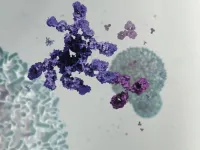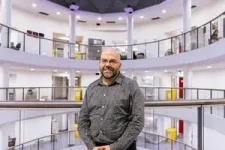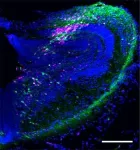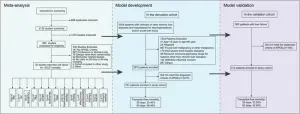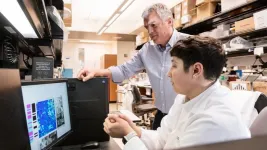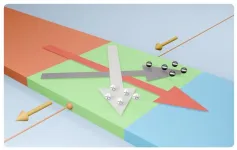(Press-News.org) A multinational collaboration co-led by the Garvan Institute of Medical Research has uncovered a potential explanation for why some cancer patients receiving a type of immunotherapy called checkpoint inhibitors experience increased susceptibility to common infections.
The findings, published in the journal Immunity, provide new insights into immune responses and reveal a potential approach to preventing the common cancer therapy side effect.
“Immune checkpoint inhibitor therapies have revolutionised cancer treatment by allowing T cells to attack tumours and cancer cells more effectively. But this hasn’t been without side effects – one of which is that approximately 20% of cancer patients undergoing checkpoint inhibitor treatment experience an increased incidence of infections, a phenomenon that was previously poorly understood,” says Professor Stuart Tangye, co-senior author of the study and Head of the Immunology and Immunodeficiency Lab at Garvan.
“Our findings indicate that while checkpoint inhibitors boost anti-cancer immunity, they can also handicap B cells, which are the cells of the immune system that produce antibodies to protect against common infections. This understanding is a critical first step in understanding and reducing the side effects of this cancer treatment on immunity.”
Insights to improve immunotherapy
The researchers focused on the molecule PD-1, which acts as a ‘handbrake’ on the immune system, preventing overactivation of T cells. Checkpoint inhibitor therapies work by releasing this molecular ‘handbrake’ to enhance the immune system’s ability to fight cancer.
The study, which was conducted in collaboration with Rockefeller University in the USA and Kyoto University Graduate School of Medicine in Japan, examined the immune cells of patients with rare cases of genetic deficiency of PD-1, or its binding partner PD-L1, as well as animal models lacking PD-1 signalling. The researchers found that impaired or absent PD-1 activity can significantly reduce the diversity and quality of antibodies produced by memory B cells – the long-lived immune cells that ‘remember’ past infections.
“We found that people born with a deficiency in PD-1 or PD-L1 have reduced diversity in their antibodies and fewer memory B cells, which made it harder to generate high-quality antibodies against common pathogens such as viruses and bacteria,” says Dr Masato Ogishi, first author of the study, from Rockefeller University.
Professor Tangye adds: “This dampening of the generation and quality of memory B cells could explain the increased rates of infection reported in patients with cancer receiving checkpoint inhibitor therapy.”
Co-author Dr Kenji Chamoto, from Kyoto University, says, “PD-1 inhibition has a ‘yin and yang’ nature: it activates anti-tumour immunity but at the same time impedes B-cell immunity. And this duality seems to stem from a conserved mechanism of immune homeostasis.”
New recommendation for clinicians
The researchers say the findings highlight the need for clinicians to monitor B cell function in patients receiving checkpoint inhibitors and point to preventative interventions for those at higher risk of infections.
Co-senior author Dr Stéphanie Boisson-Dupuis, from Rockefeller University, says, “Although PD-1 inhibitors have greatly improved cancer care, our findings indicate that clinicians need to be aware of the potential trade-off between enhanced anti-tumour immunity and impaired antibody-mediated immunity.”
“One potential preventative solution is immunoglobulin replacement therapy (IgRT), an existing treatment used to replace missing antibodies in patients with immunodeficiencies, which could be considered as a preventative measure for cancer patients at higher risk of infections,” she says.
From rare cases to insights to benefit all
“Studying cases of rare genetic conditions such as PD-1 or PD-L1 deficiency enables us to gain profound insights into how the human immune system normally works, and how our own manipulation of it can affect it. Thanks to these patients, we’ve found an avenue for fine-tuning cancer immunotherapies to maximise benefit while minimising harm,” says Professor Tangye.
Looking ahead, the researchers will explore ways to refine checkpoint inhibitor treatments to maintain their powerful anti-cancer effects while preserving the immune system’s ability to fight infections.
“This research highlights the potential for cancer, genomics and immunology research to inform one another, enabling discoveries that can benefit the broader population,” says Professor Tangye.
--ENDS—
Professor Stuart Tangye is a Conjoint Professor at St Vincent's Clinical School, Faculty of Medicine and Health, UNSW Sydney.
END
Study reveals cause of common cancer immunotherapy side effect
New insights into how checkpoint inhibitors affect the immune system could improve cancer treatment
2024-11-26
ELSE PRESS RELEASES FROM THIS DATE:
New era in amphibian biology
2024-11-26
Amphibians hold a significant place in evolution, representing the transition from aquatic to terrestrial lifestyles. They are crucial for understanding the brain and spinal cord of tetrapods—animals with four limbs, including humans. A group of scientists led by a team at the Institute of Science and Technology Austria (ISTA) now shows how harmless viruses can be used to illuminate the development of the frog nervous system. The results have now been published in Developmental Cell.
Virus. When you hear the word, you probably shudder. But not all viruses are bad or cause disease. Some are even used for therapeutic ...
Harbor service, VAST Data provide boost for NCSA systems
2024-11-26
The National Center for Supercomputing Applications and VAST Data are giving supercomputing system Delta and the newly launched DeltaAI a boost in their storage and application performance.
NCSA launched Harbor, a service that provides very fast storage for global home and software directories across all NCSA open-science resources. Its deployment has led to a 400% increase in application launch performance for the Delta system, among many other gains.
Over the last two years, we’ve seen a significant increase in ...
New prognostic model enhances survival prediction in liver failure
2024-11-26
Researchers have unveiled a groundbreaking advancement in liver failure care: the CATCH-LIFE-MELD score (Chinese Acute-on-Chronic Liver Failure Consortium (CATCH-LIFE)-MELD score). This innovative tool, developed by an international team led by Xia Yu and colleagues, enhances the accuracy of predicting short-term survival outcomes for patients suffering from acute-on-chronic liver failure (ACLF). The study, published in eGastroenterology, promises to revolutionize patient management and treatment planning for this life-threatening condition.
“ACLF presents unique challenges due to its rapid progression and high mortality rates,” said Dr. Yu Shi, senior researcher at Zhejiang University ...
China focuses on improving air quality via the coordinated control of fine particles and ozone
2024-11-26
A recent special issue of the journal Atmospheric and Oceanic Science Letters has brought together some of China's top scientists to provide a picture of the latest progress in understanding and controlling air pollution.
Fine particulate matter, referred to as PM2.5, and ground-level ozone (O3) are the main pollutants degrading the air quality of China’s cities and wider urban regions. Both have serious human health effects, such as heart disease, asthma, and lung damage.
The World Health Organization (WHO) provides clear guidelines regarding acceptable concentrations ...
Machine learning reveals behaviors linked with early Alzheimer’s, points to new treatments
2024-11-26
SAN FRANCISCO—November 26, 2024—Subtle signs of Alzheimer’s disease can emerge decades before a diagnosis—often in the form of irregular behaviors that reflect very early stages of brain dysfunction.
But until now, identifying and measuring these slight behavioral changes in a scientific way hasn’t been feasible, not even when studying Alzheimer’s in mice.
In a study published in Cell Reports, a team of scientists at Gladstone Institutes used a new video-based machine learning tool to pinpoint ...
Novel gene therapy trial for sickle cell disease launches
2024-11-26
UCSF Benioff Children's Hospital Oakland is enrolling patients in an innovative clinical trial that seeks to cure sickle cell disease. The trial is the first in the U.S. to apply non-viral CRISPR-Cas9 gene-editing technology in humans to directly correct the genetic mutation that causes the disease.
The research involves taking the patient’s blood stem cells to correct the mutation and returning those edited cells to the patient through a bone marrow transplant. It’s hoped the corrected blood stem cells will then multiply and create a new blood system, one free of sickle cell.
“This ...
Engineering hypoallergenic cats
2024-11-26
Gene editing could create hypoallergenic cats, according to a sequence analysis of the protein that triggers allergies to cats. Some 15% of people are allergic to cats, and symptoms can be severe. Martin D. Chapman and colleagues investigated CH1 and CH2, genes that code for the allergen, Fel d 1. Cats produce Fel d 1 in their sebaceous, salivary, perianal, and lachrymal glands. The function of Fel d 1 is unknown but comparisons of Fel d 1 sequences and homologs from 276 domestic or exotic cats—including cougars, cheetahs, lions, tigers, and jaguars, among others—suggests that CH1 and CH2 have been under active selection, and ...
Microwave-induced pyrolysis: A promising solution for recycling electric cables
2024-11-26
The demand for electronics has led to a significant increase in e-waste. In 2022, approximately 62 million tons of e-waste were generated, marking an 82% increase from 2010. Projections indicate that this figure could rise to 82 million tons by 2030. E-waste contains valuable materials such as metals, semiconductors, and rare elements that can be reused. However, in 2022, only 22.3% of e-waste was properly collected and recycled, while the remaining materials, estimated to be worth almost $62 billion, were discarded in landfills. Although efforts to improve e-waste recycling continue, the process remains labor-intensive, and a significant portion of e-waste ...
Cooling with light: Exploring optical cooling in semiconductor quantum dots
2024-11-26
Cooling systems are an integral part of many modern technologies, as heat tends to wear down materials and decrease performance in several ways. In many cases, however, cooling can be an inconvenient and energy-intensive process. Accordingly, scientists have been seeking innovative and efficient methods to cool substances down.
Solid-state optical cooling is a prominent example that leverages a very unique phenomenon called anti-Stokes (AS) emission. Usually, when materials absorb photons from incoming light, their electrons transition into an “excited” state. Under ideal conditions, as electrons return to their original ...
Breakthrough in clean energy: Scientists pioneer novel heat-to-electricity conversion
2024-11-26
Thermoelectric materials, which convert heat into electricity, are valuable tools for capturing waste heat and turning it into usable electricity. These materials are especially useful in industries and vehicles where engines produce a lot of waste heat, improving energy efficiency by converting it into additional power. They also exhibit potential for portable power generation, in remote sensors and satellites where traditional power sources may be impractical.
Traditional thermoelectric devices, known as parallel thermoelectric devices, generate a voltage in the same direction as the heat ...
LAST 30 PRESS RELEASES:
Norbert Holtkamp appointed director of Fermi National Accelerator Laboratory
New agentic AI platform accelerates advanced optics design
Biologists discover neurons use physical signals — not electricity — to stabilize communication
Researchers discover that a hormone can access the brain by hitchhiking
University of Oklahoma researcher awarded funding to pursue AI-powered material design
Exploring how the visual system recovers following injury
Support for parents with infants at pediatric check-ups leads to better reading and math skills in elementary school
Kids’ behavioral health is a growing share of family health costs
Day & night: Cancer disrupts the brain’s natural rhythm
COVID-19 vaccination significantly reduces risk to pregnant women and baby
The role of vaccination in maternal and perinatal outcomes associated with COVID-19 in pregnancy
Mayo Clinic smartwatch system helps parents shorten and defuse children's severe tantrums early
Behavioral health spending spikes to 40% of all children’s health expenditures, nearly doubling in a decade
Digital cognitive behavioral treatment for generalized anxiety disorder
Expenditures for pediatric behavioral health care over time and estimated family financial burden
Air conditioning in nursing homes and mortality during extreme heat
The Alps to lose a record number of glaciers in the next decade
What makes a good proton conductor?
New science reporting guide published for journalists in Bulgaria
New international study reveals major survival gaps among children with cancer
New science reporting guide published for journalists in Turkey
Scientists develop a smarter mRNA therapy that knows which cells to target
Neuroanatomy-informed brain–machine hybrid intelligence for robust acoustic target detection
Eight SwRI hydrogen projects funded by ENERGYWERX
The Lundquist Institute and its start-up company Vitalex Biosciences Announces Strategic Advancement of Second-Generation fungal Vaccine VXV-01 through Phase 1 Trials under $40 Million Competitive Con
Fine particles in pollution are associated with early signs of autoimmune disease
Review article | Towards a Global Ground-Based Earth Observatory (GGBEO): Leveraging existing systems and networks
Penn and UMich create world’s smallest programmable, autonomous robots
Cleveland researchers launch first major study to address ‘hidden performance killer’ in athletes
To connect across politics, try saying what you oppose
[Press-News.org] Study reveals cause of common cancer immunotherapy side effectNew insights into how checkpoint inhibitors affect the immune system could improve cancer treatment
